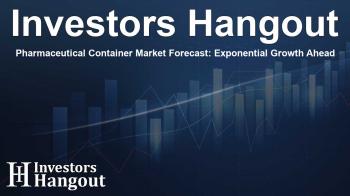Pharmaceutical Container Market Forecast: Exponential Growth Ahead

Dynamic Outlook on the Pharmaceutical Container Market
The demand for pharmaceutical containers continues to surge dramatically as the industry shifts toward more secure, efficient, and environmentally friendly packaging solutions. This ongoing evolution paves the way for innovation in packaging methods, addressing the rigorous needs for maintaining drug integrity and ensuring patient safety.
Market Overview and Projected Growth
Recent research indicates that the global pharmaceutical container market was valued at approximately USD 97.63 billion and is estimated to escalate to USD 189.45 billion by 2034, exhibiting a compound annual growth rate (CAGR) of around 6.98% during this period. This remarkable growth trajectory can be attributed to the increasing demands posed by an ageing population and the prevalence of chronic diseases, necessitating reliable pharmaceutical packaging.
Market Driving Forces
One of the primary catalysts behind this growth is the escalating demand for pharmaceutical products across the globe. As healthcare requirements expand, securing dependable and sustainable packaging solutions has become increasingly crucial to ensure drug integrity and compliance with enhanced regulatory standards.
Innovations in Pharmaceutical Container
Prominent companies such as Amcor Plc and Becton, Dickinson and Company are leading the charge in innovating smart containers that combine safety with sustainability. Innovations like tamper-evident packaging and child-resistant options are being prioritized to satisfy the growing consumer demand for quality drug packaging. As a direct response to increasing regulatory pressures, businesses are compelled to adopt novel solutions that ensure environmental effectiveness without compromising product safety.
Growing Global Health Needs
The pharmaceutical sector's growth is mirrored by the rising global health needs, notably influenced by the ageing population that requires constant medical attention. For instance, major players like Berry Global Healthcare have recently introduced innovative devices, including a new inhaler and an eye drop nozzle aimed at improving patient compliance and drug delivery efficiencies.
Regional Insights on the Pharmaceutical Container Market
The pharmaceutical container market exhibits distinct characteristics across various regions, with North America and Europe currently holding significant market shares. In North America, the focus on regulatory compliance and innovative packaging materials has led to strong sector growth, while Europe continues to prioritize environmental sustainability, further driving the demand for recyclable packaging solutions.
Emerging Opportunities in Asia-Pacific
Meanwhile, the Asia-Pacific region is rapidly evolving as a key manufacturing hub for pharmaceutical products, particularly in countries like China and India. The escalating healthcare infrastructure investments are fostering a robust demand for safe and efficient pharmaceutical containers, supporting their burgeoning biotechnology sectors.
Infrastructure Advancements in LAMEA
In the LAMEA (Latin America, the Middle East, and Africa), we observe surging investments in healthcare infrastructure that harmonize with the expanding pharmaceutical manufacturing landscape. The increasing emphasis on regulatory standards and product purity further enhances the need for sophisticated packaging technologies, which cater to complex product requirements.
Competitive Landscape
The competitive environment in the pharmaceutical container market is shaping up, with a mix of well-established leaders and innovative newcomers. Companies such as Catalent Inc. and Schott AG are at the forefront, continuously advancing packaging solutions that meet the current needs of the pharmaceutical industry. Their strategic efforts to innovate and optimize packaging materials highlight the importance of sustaining product quality and compliance in a fast-evolving market.
Frequently Asked Questions
What is the current projected size of the pharmaceutical container market?
The market size is expected to reach approximately USD 189.45 billion by 2034.
Which factors are driving the growth of the pharmaceutical container market?
Growing healthcare demands, the aging population, and technological advancements in packaging solutions are primary growth drivers.
What role do leading companies play in the pharmaceutical container market?
Leading companies are innovating by developing secure and environmentally sustainable packaging solutions, contributing to enhanced drug delivery and compliance.
How is the market segmented?
The market is segmented by product type, material type, and region, including major segments like plastics, glass, and metal containers.
What are the expected trends leading to market changes in the future?
Increased focus on sustainability, innovations in smart packaging, and advanced drug delivery systems are projected to influence future market trends significantly.
About The Author
Contact Kelly Martin privately here. Or send an email with ATTN: Kelly Martin as the subject to contact@investorshangout.com.
About Investors Hangout
Investors Hangout is a leading online stock forum for financial discussion and learning, offering a wide range of free tools and resources. It draws in traders of all levels, who exchange market knowledge, investigate trading tactics, and keep an eye on industry developments in real time. Featuring financial articles, stock message boards, quotes, charts, company profiles, and live news updates. Through cooperative learning and a wealth of informational resources, it helps users from novices creating their first portfolios to experts honing their techniques. Join Investors Hangout today: https://investorshangout.com/
The content of this article is based on factual, publicly available information and does not represent legal, financial, or investment advice. Investors Hangout does not offer financial advice, and the author is not a licensed financial advisor. Consult a qualified advisor before making any financial or investment decisions based on this article. This article should not be considered advice to purchase, sell, or hold any securities or other investments. If any of the material provided here is inaccurate, please contact us for corrections.

